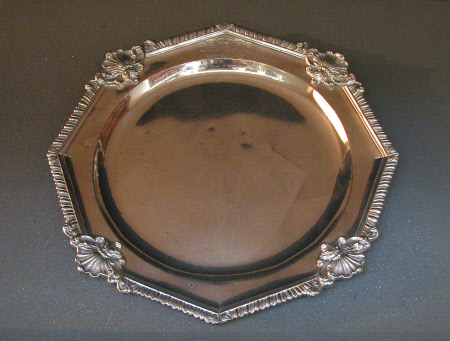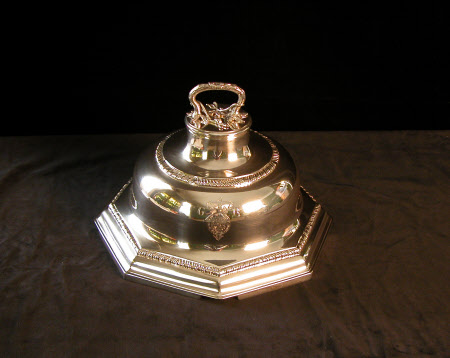Octagonal dish and cover
probably Frederick Kandler
Category
Silver
Date
circa 1751 - circa 1758
Materials
Silver
Measurements
2.9 x 32.4 cm (dish); 18.4 x 25.4 cm (cover)
Place of origin
London
Order this imageCollection
Ickworth, Suffolk
NT 852115.1
Summary
One of four octagonal dishes, probably by Frederick Kandler, London, circa 1751, and one of four associated octagonal dish covers, silver, probably London, circa 1758. The dish is raised with a shallow circular well, a broad rim and a cast octagonal gadrooned border with palm leaves at four of the angles and cast scallop shells with pearl bands and flanking foliate scrolls at the other four. The cover is raised and has a stepped octagonal base conforming to the dishes. The base terminates in a chased band of gadrooning and the cover rises as a circular convex dome to another chased gadroon band, then rises again in reverse form to an applied flat top plate, the joint concealed by a cast and seemed moulding. The cast and chased tendril handle is capped by single flowers and held on by a silver bolt and nut. Heraldry: The rim of the dish is engraved with the quartered shield, supporters and motto of the 2nd Earl of Bristol in an ermine mantling and beneath an earl’s coronet. On the front of the cover are engraved the quartered arms of the Hanoverian monarchs (pre-1801) within the Garter and beneath an imperial crown flanked by the initials G R. Hallmarks: There are no marks on either the dishes or the covers. Scratchweights: Dish - ‘N1 [/] 33=10’ Cover - ‘Nº 1 = 31=3’
Full description
For further detail see the master object entry.
Provenance
Dish: George Hervey, 2nd Earl of Bristol (1721-75); by descent to the 4th Marquess of Bristol (1863-1951); accepted by the Treasury in lieu of death duties in 1956 and transferred to the National Trust. Cover: Jewel Office; allocated to George Hervey, 2nd Earl of Bristol (1721-75) as Ambassador to Madrid 1758; discharged to Lord Bristol 9 April 1759; by descent to the 4th Marquess of Bristol (1863-1951); accepted by the Treasury in lieu of death duties in 1956 and transferred to the National Trust.
Credit line
Ickworth, the Bristol Collection (National Trust)
Makers and roles
probably Frederick Kandler, goldsmith

